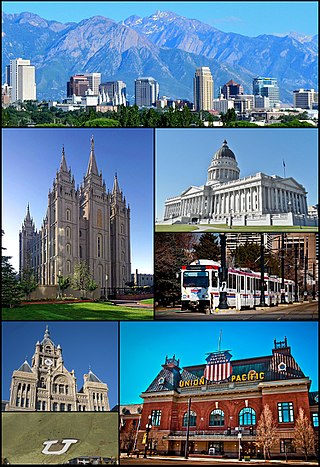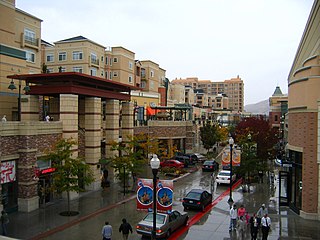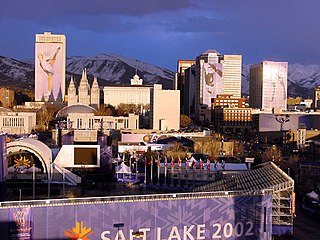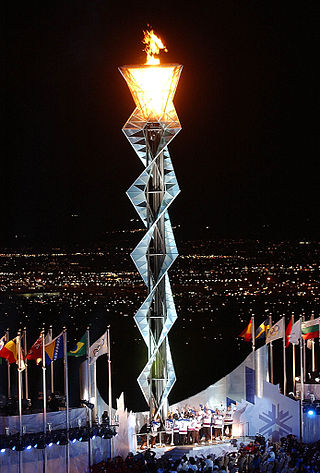
The 2002 Winter Olympics, officially the XIX Olympic Winter Games and commonly known as Salt Lake 2002, was an international winter multi-sport event that was held from February 8 to 24, 2002 in and around Salt Lake City, Utah, United States.

Salt Lake City (SLC), often shortened to Salt Lake, is the capital and most populous city of Utah, United States. It is the seat of Salt Lake County, the most populous county in Utah. With a population of 200,133 in 2020, the city is the core of the Salt Lake City metropolitan area, which had a population of 1,257,936 at the 2020 census. Salt Lake City is further situated within a larger metropolis known as the Salt Lake City–Ogden–Provo Combined Statistical Area, a corridor of contiguous urban and suburban development stretched along a 120-mile (190 km) segment of the Wasatch Front, comprising a population of 2,746,164, making it the 22nd largest in the nation. It is also the central core of the larger of only two major urban areas located within the Great Basin.

The 2002 Winter Paralympics, the eighth Paralympic Winter Games, were held in Salt Lake City, Utah, United States, from March 7 to 16, 2002. A total of 416 athletes from 36 nations participated. They were the first Winter Paralympics in the American continent. These were the first Paralympic Winter Games for Andorra, Chile, China, Croatia, Greece, and Hungary. Ragnhild Myklebust of Norway won five gold medals in skiing and biathlon, becoming the most successful Winter Paralympic athlete of all time with 22 medals, 17 of them gold.

Rice–Eccles Stadium is an outdoor college football stadium located on the campus of the University of Utah in Salt Lake City, Utah. It is the home field of the Utah Utes of the Pac-12 Conference. It served as the main stadium for the 2002 Winter Olympics; the Opening and Closing Ceremonies were held at the stadium, which was temporarily renamed "Rice–Eccles Olympic Stadium".

Downtown is the oldest district in Salt Lake City, Utah. The grid from which the entire city is laid out originates at Temple Square, the location of the Salt Lake Temple.

The Gateway is a large, open-air retail, residential, and office complex in Salt Lake City, Utah, United States. It is centered on the historic Union Pacific Depot on the west side of Downtown Salt Lake City between 50 North and 200 South streets and between 400 and 500 West streets. Rio Grande Street has been the site of many special events and becomes a one-way street and heads north through the center. The center has featured as many as 89 outlets, but recent changes have allowed the center to provide new retail shopping experiences and become more of a social gathering place centered on dining and nightlife.

Margaret "Deedee" McMullen Corradini was an American businesswoman and politician who served as the 32nd mayor of Salt Lake City, Utah from 1992 to 2000. Corradini was the first woman to serve as mayor of Salt Lake City.

Soldier Hollow is a cross-country ski venue located at the mouth of a hollow of the same name about 53 miles (85 km) southeast of Salt Lake City in Wasatch Mountain State Park in northwestern Wasatch County, Utah, United States. The venue was created for the 2002 Winter Olympics, and during the games it hosted the biathlon, cross-country skiing, and the cross country skiing portion of the Nordic combined events. Since hosting the Olympics, it has been developed as a cross-country skiing, tubing, and snowshoeing venue, while featuring mountain biking and golfing in the summer. On May 1, 2016, the venue operation contract transferred from the Soldier Hollow Legacy Foundation to the Utah Olympic Legacy Foundation, which owns and operates several Olympic and Paralympic legacy venues elsewhere in the state.

Snowbasin Resort is a ski resort in the western United States, located in Weber County, Utah, 33 miles (53 km) northeast of Salt Lake City, on the back (east) side of the Wasatch Range.

The University Line is an obsolete designation to a light rail line of Utah Transit Authority's (UTA) TRAX system in Salt Lake City. It was the second TRAX line opened by UTA, after the Sandy/Salt Lake Line opened in 1999. The original line ran from the Delta Center Station to the Stadium Station, which is west of the Rice-Eccles Stadium on the University of Utah campus. The eastern end of the line was extended to the University Medical Center Station in 2003, and the western end was extended in 2008 to the new Salt Lake City Intermodal Hub. The University Line continued running under that name through August 6, 2011, after which this designation was no longer used following a system redesign. The University of Utah is now served by the Red Line.

The Hoberman Arch was the centerpiece of the Olympic Medals Plaza in downtown Salt Lake City during the 2002 Winter Olympics. Following the Olympics the arch was moved to the Salt Lake 2002 Olympic Cauldron Park where, along with the Olympic cauldron, it was one of the main highlights and an important part of Salt Lake's Olympic legacy. In August 2014, the arch was removed from the park and a new public display location has not yet been found.

The Olympic and Paralympic Cauldron Plaza is located outside the southwestern corner of Rice–Eccles Stadium on the campus of the University of Utah in Salt Lake City, Utah. During the 2002 Winter Olympics and Paralympics, the stadium was known as Rice-Eccles Olympic Stadium and hosted the Opening and Closing Ceremonies. Currently, the plaza contains the 2002 Winter Olympics cauldron surrounded by several plaques displaying photographs and information related to the 2002 Games.

The Utah Olympic Oval is an indoor speed skating oval located 14 miles (23 km) southwest of Salt Lake City, in Kearns, Utah. The Oval was built for the 2002 Winter Olympics and it hosted the long track speed skating events for the 2002 games. Inside the facility the 400 meter skating track surrounds two international sized ice sheets, and is itself surrounded by a 442 meter running track. Due to its high altitude, 4,675 feet (1,425 m), and the associated low air resistance, ten Olympic records and nine world records were set at the Oval during the 2002 games, the largest number of world records ever set at one event.

Vivint Arena, formerly known as EnergySolutions Arena and Vivint Smart Home Arena, is an indoor arena located in Salt Lake City, Utah. The arena serves as the home venue for the National Basketball Association (NBA)'s Utah Jazz, and has been the home venue for other professional athletic teams, such as the Arena Football League's Utah Blaze and the Women's National Basketball Association (WNBA)'s Utah Starzz. It seats 18,306 for basketball, 14,000 for ice hockey and indoor football, and 20,000 for concerts. It also has 56 luxury suites and 668 club seats.

Legacy Parkway is an 11.5-mile-long (18.5 km) four-lane controlled-access parkway located almost completely within Davis County in the northern part of the U.S. state of Utah. The parkway travels north from Interstate 215 (I-215) in northwestern Salt Lake City to an interchange named the Wasatch Weave in Farmington with two intermediate interchanges providing access to Woods Cross and Centerville. Wetlands of the nearby Great Salt Lake and nature preserves border the western side of the parkway while the eastern side roughly parallels Union Pacific and Utah Transit Authority rail lines and I-15. On average, between 20,000 and 23,000 vehicles use the parkway daily.

The 2002 Winter Olympic Games were held in and around Salt Lake City, United States from February 8 to 24, 2002, and the Paralympics from March 7 to 16, 2002. The sporting events were held in ten competitive venues, while non-competitive events, such as the opening ceremony, were held in six other venues. Three venues were also created for training purposes. All Olympic venues were scattered throughout Northern Utah.

One Voice Children's Choir is an American children's choir in Utah.

Go for the Gold is a sculpture by Jonathan Bronson.

The 2002 Winter Olympics cauldron held the Olympic flame during the 2002 Winter Olympics held in Salt Lake City, Utah, United States.

The Joe Quinney Winter Sports Center is a museum building within the Utah Olympic Park in Summit County, Utah, United States, that houses both the Alf Engen Ski Museum and the Eccles Salt Lake 2002 Olympic Winter Games Museum, as well as the main offices of the Utah Athletic Foundation. The center stands next to the day lodge and summer splash pool in the park.






















